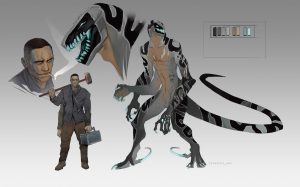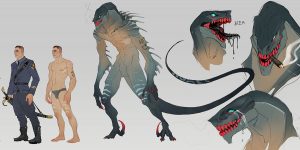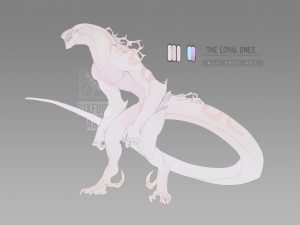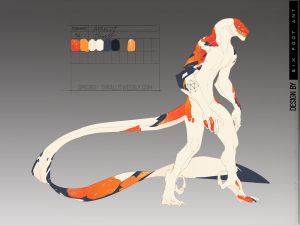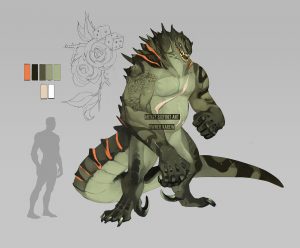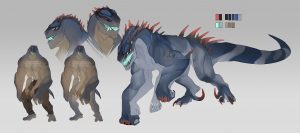Physiology
Anatomy: Major form
In major or ‘demon’ form, thralls vary wildly in physical appearance. The following features are usually present in a healthy example:
Smooth skin covered with extremely small scales.
- Larger scales and scutes are present on hands, joints, brow, and spinal ridge.
- ‘Sickle’ or ‘scythe’ claws on the innermost toe. Generally scythe claws are between 6 and 10 inches long, with a bladelike edge on the inside of the curve. They are held backwards off the ground to prevent blunting and damage.
- At least some spines on the back of the neck, spinal ridge and elbows. These may be reduced or absent in females.
- Comfortable on two or four feet. Thralls generally prefer to run on all fours and stand upright at other times.
- Height between 10 and 14 feet when standing upright.
Anatomy: Home form
The human-like form has historically been referred to as ‘home’ or minor form. Again, much variation is possible, but the following are always present:
- A snake-like groove extending from cheek to ear, where the jaw can be unhinged.
- Pectoral ‘shed lines’ where skin will split during primary and tertiary moults.
- Average of 6 feet tall, maximum of 9.
Other monstrous features are also common, even among very human-like thralls:
- Sharp teeth.
- Angular bone structure, ranging from near-human to highly distorted and major-like.
- Eyes wide-set and bright.
- Spines and scutes on the face, neck and scalp and down the spine.
- ‘Shadow markings’ on the skin, where high contrast markings in major form are still faintly visible in home form.
- Iris colored yellow, amber, white or other colors unlikely in humans.
Home form appearance usually reflects the major form, and a more human-like appearance is considered desirable. Many thralls living closely with humans will break their spines off, and those with sharp teeth often have a close-lipped way of talking.
Sex and Reproduction
Despite outward appearances, thralls are still mammals. Pregnancies last an average of seven months, but can be as low as six if the female is in combat and regularly consuming aurum. Newborn infants are almost as helpless as human infants, though they gain coordination and muscle at a higher rate. Most are able to walk confidently by four months of age. Although thrall infants nurse for their primary source of nutrition, they have a tendancy to eat anything vaguely food-like in their surroundings, especially meat. By the time they are weaned (around one year old), the average thrall baby has crammed hundreds of insects, small mammals, eggs, bones and other ‘foods’ into their mouth.
On average, thralls still bear one infant in each pregnancy, just as their human ancestors do. There are however individuals with supernumerary ovaries or other mutations that result in multiple-infant pregnancies. Some of these ‘hyper-females’ regularly bear four or more infants in each pregnancy. Humans predictably refer to these as ‘litters’, and the idea has captured the public imagination. Ask the average human on the street how many babies a thrall female bears, and they will probably answer closer to ten.
Thrall resilience means low infant mortality and high birth rate. Most intersex individuals also seem to be capable of producing children in one capacity or another, though those without a complete womb might need a female partner.
